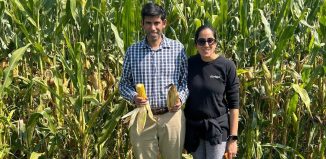Oleg Gang, an innovator in building miniature materials
He creates materials that build themselves. By attaching parts that will connect in a specific way, he can build something that could be useful in fields ranging from harvesting energy, to advancing medical technology to offering clearer views in basic research.
Oleg Gang, a group leader in soft and bio-nanomaterials at the Center for Functional Nanomaterials at Brookhaven National Laboratory, is at the forefront of a field where the materials he’s trying to construct are about 1/1000th the width of a human hair.
At incredibly small scales, matter behaves in ways that are different from the world of apples falling from trees, cars slowing down on snowy roads, or baseballs flying over fences. Going from atoms to molecules to nanoparticles to large objects causes matter to change its properties due to the collective effects between atoms and the relative surface contribution, Gang explained.
Gang has been using something from another area of science for these self-assembled materials: DNA. The genetic blueprint that determines whether a cell becomes a part of a snail, a snake or a salmon has matching base pairs that make it a good candidate for construction. By attaching these DNA shells to small objects, Gang can encourage the pieces to come together on their own, as combinations of base pairs seek each other out, the way puzzle pieces floating in a dish might if they had a sequence of attachments that lined up in a specific order.
Extending the puzzle analogy, Gang has been able to put together two-dimensional structures. One of the many challenges facing him and others at Brookhaven, Harvard, Northwestern and a handful of other groups with similar research goals is figuring out how to generate three-dimensional structures.
Gang’s colleagues describe him as an innovator.
“The concepts he and a small number of other groups are pursuing represent an entirely new approach to constructing materials,” said Charles Black, a group leader in materials synthesis and characterization at the CFN. Gang is considered “an excellent scientist, making breakthrough discoveries while remaining careful in his work and sure of his scientific claims.”
Gang, who has several patents awarded with others pending, studies the basics of these self-assembly processes, hoping to understand more about how to build structures with more complex architecture.
He also takes requests from other scientists, who are looking to improve on existing products or who want to tap into his expertise to refine a product they already use.
He started his work with gold, but has now expanded to other classes of nanoparticles, including magnetic, catalytic, fluorescent and metallic.
Gang said he has helped improve various properties through self assembly. A few years ago, he said, he raised the light-emitting ability of a nanoparticle by a factor of five. That, he said, might prove useful in biodetection.
He also published results where he improved the ability of a detector to find the chirality, or spin, of particles, by a factor of 100.
Gang is developing research that will enable the structures he creates to transform to something else.
“A structure is the result of a particular interaction,” he said. “As soon as we change how the particles interact — they are not happy and are trying to find another configuration — they will change into something different.”
Gang said he benefits from working at the 7-year-old Center for Functional Nanomaterials, where he can not only work with a team of faculty fluent in the world of nanoscience, but where he can also collect additional information at the National Synchrotron Light Source and from electron microscopes.
Science, Gang said, often benefits by imitating nature. A plane, for example, isn’t a bird, although both can fly.
Gang believes his work is not at the early Leonardo DaVinci stage of flight, but is rather closer to the Wright Brothers, where he and other scientists can lift the plane off the ground, but can’t fly it yet.
Gang, who grew up in the western part of the Ukraine and then moved to Israel, now lives in Setauket with his wife, Alina, who works for a biodetection company in Medford. The couple’s 19-year-old daughter, Danielle is studying creative writing at SUNY Potsdam. They also have a 15-year-old son, Gabriel.
As for his work, Gang is excited about the prospects for contributing to science and society.
“We’re in a situation where many types of things become possible,” he said.






